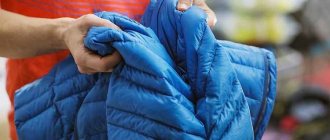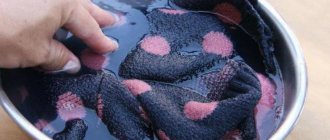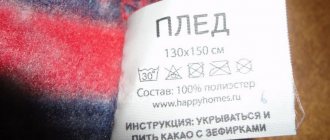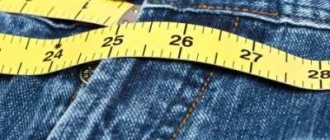Linen is one of the most popular natural materials. Therefore, many housewives want to know how to wash linen. The advantages of this material are obvious - they are hygienic, comfortable (you won’t get hot in such clothes, even if they are thick), and the possibility of long-term use.
The housewife may only have questions about care, because, like cotton, if washed incorrectly, linen materials can shrink, wrinkle, or undergo other deformation. Therefore, you purchased a linen dress, and have not dealt with this material before, you need to learn how to wash it correctly.
This article will explain at what temperature to wash linen and how to wash linen in a machine, as well as the subtleties of use. Often modern material manufacturers add synthetic threads to the fabric, perform heat treatment, etc. Such fabrics are much less susceptible to shrinkage, deformation and fading.
Choosing a method for washing linen
If you have a question about whether linen can be washed in a machine, then it’s worth saying: hand washing this material is preferable. But if your SMA has a delicate wash program, then you can remove dirt by machine.
Choosing a detergent
The main advantage of linen is that it becomes better and more pleasant to the touch with each subsequent wash. If you do not want to ruin your clothes, it is recommended to choose the right detergents. The use of chlorine powders is prohibited, otherwise the fabric fibers will become thinner, and a loss of strength and attractiveness is guaranteed. Therefore, when purchasing, study the composition of the powder. Wash white items with regular powder, colored items - accordingly, for colored items. This way you will be able to preserve the brightness and color saturation of the fabric for a long time. To soften, be sure to rinse your laundry by adding fabric softener to the container.
Recommendation! Use oxygen bleach when washing overly soiled whites. When washing colored items or clothes with embroidery, sequins and rhinestones, do not use bleach.
Features of caring for linen fabric with embroidery
When washing
- It's better to wash by hand. Just don't rub it with your hands. Gently rub any visible dirt on the embroidery with a soft-bristled brush. Machine wash is also suitable. You need to set the “delicate mode” and cancel the spin cycle. Place the embroidered item in the drum in a special bag or an ordinary pillowcase made of non-fading material.
- Do not use powder with a bleaching effect or bleach under any circumstances, as the colored threads of the design will lose their color.
- Use powder for delicate fabrics or in liquid form.
- After washing, rinse the item well. When using manual water, change the water 2-3 times; when using machine water, select the “extra rinse” mode.
- During washing, embroidery threads can sometimes stain the area around them. On white items this can be eliminated with bleach. Wrap some cotton wool around a match or toothpick, soak it in bleach and wipe the painted areas without touching the embroidery. Afterwards wash the product well.
- During the last rinse, you can add vinegar (a tablespoon per liter of water). This will preserve and strengthen the color of the embroidery.
- You cannot wring out an item by twisting it. Run your hands over it from top to bottom. This way most of the water will come off. Wrap it in a non-fading terry towel and pat dry. Then place the item between two dry towels and iron it. Or hang it on a line or dryer, wait for the laundry to dry, and start ironing. The item must be damp.
When ironing
- The area with embroidery should be ironed from the wrong side. Place a soft cloth under it in advance. Then it will not be flattened by the iron and will retain its texture.
- The tightened fabric around the embroidery can be straightened by steaming.
- If there are still bruises on the product around the embroidery, you need to put something heavy with a flat surface on them while they are still warm after ironing, for example, dictionaries, a stack of notebooks. Just first lay non-colored polyethylene under them so that the paint from the covers of books or notebooks does not stain the fabric. Press until completely dry.
- Small spaces of fabric between small embroidery details can be smoothed with steam. Use a steam generator or an iron with a vertical steam function.
- After ironing, do not immediately put things away in the closet. They need another 20-30 minutes to dry.
Hand wash
Let's first look at how to properly wash linen by hand. There are several steps that will help you wash your clothes carefully and carefully without ruining them:
- Prepare your clothes before washing. Check your pockets and empty them. Close the zippers. If there are stains, they should be removed first.
- Fill a container with warm water - this is necessary for complete and uniform distribution of things and powder. Add detergent.
- When washing white items, soak them in the solution for half an hour. It is better to wash colored items immediately.
- Wash gently.
- Rinse the washed clothes until all the powder is washed off.
- There is no need to wring out so as not to deform the fabric. To remove excess moisture from the glass, hang it on a hanger (clothes dryer, rope), and place a basin.
Selecting a detergent
- Unpainted items can be washed with regular chlorine-free powder or laundry soap. Chlorine can damage the fiber structure and turn a durable and wear-resistant item into a brittle one.
- On undyed fabrics, non-chlorine bleaches, such as oxygen bleaches, can be used. They have a gentle effect on the fibers without destroying their structure.
- You can also add water softeners, balms, and fabric softeners.
Useful
It is better to wash colored items made of linen fabric with special liquid detergents, powder for washing colored and children's underwear. Thin and loose fabrics can only be washed by hand in warm water.
We wash in SMA
You can wash linen clothes not only by hand. Don't know what temperature to wash linen at? You will learn about this below.
Temperature
Finding out at what temperature to wash is easy - look for the manufacturer's tag on the inside seam of the garment.
The washing temperature for white linen should not exceed 60 degrees. High temperatures and boiling are contraindicated for bright and colored items. The optimal mode is from 30 to 40 degrees. How to wash linen in a washing machine? To wash linen, follow these steps:
- Before washing, pre-remove stains.
- To prevent white streaks and streaks from appearing on your clothes, avoid using stain remover when washing.
- There should be enough free space in the washing machine drum. If you have a lot of clothes, divide them into two washes.
- Now you can set the delicate wash program and temperature mode and wait until the cycle ends.
Do you know if linen shrinks when washed? Most housewives are afraid to wash linen items precisely because of this, because they “shrink.” Below we will tell you how to wash linen items so that they do not shrink.
First contact of new clothes with water
Particular attention should be paid to the first wash of a linen item, since it is this treatment that can cause the most severe shrinkage.
Please note the following information:
- preference is given to hand washing, as it is more gentle;
- if the fabric is colored, then it is pre-soaked in a weak vinegar solution (1 tbsp per 1 liter of water);
- after 15-30 minutes, the item is rinsed and sent to dry - this allows the dye to be fixed in the material;
- if the item has not been worn or used, then there is no need to add washing powder;
- To make the fabric softer, you can use fabric softener.
When it was decided to use a washing machine for the first wash of a new item, they turn on the gentle mode. Features of manual settings: water – up to 40 degrees, spin disabled.
Nuances
Linen is prone to color loss and shrinkage. Removing stains can damage the fabric. Let's talk about possible risks.
Coloring
If you wash linen clothes incorrectly, they may become stained. Therefore, the use of powders with colored granules is not recommended. Hand washing requires more water to allow clothes to float freely. Lack of water can lead to shedding. When rinsing, be sure to wash the item until the foam is washed off.
Recommendation! In order not to lose the rich shade of the fabric, when rinsing, add 1 glass of vinegar to the water, and no Lenor will be needed.
Shrinkage
Let's figure out how to wash linen so that it doesn't shrink. If the material does not contain synthetic additives, this leads to shrinkage. But after the first wear, the item will return to its original appearance. To make the item recover faster, try gently ironing it through a piece of gauze.
Prevention of shrinkage
Items that are entirely made of linen often shrink due to heat treatment. This occurs due to the use of hot water, incorrect choice of powder or poor material. To avoid such a situation, you should strictly follow the recommendations:
- do not exceed the permissible temperature limit;
- choose high-quality fabric (with a smooth surface, dense weave of fibers and resistant color);
- Use only products that are specifically designed for this type of fabric.
Drying and ironing
In order for the products to retain their original shape, it is necessary to ensure proper drying so that the linen does not spoil during ironing. Use our tips:
- Do not twist or squeeze.
- The drying room must be well ventilated. Avoid direct sunlight on brightly colored fabric.
- Don't wait until things are completely dry - iron them while still wet.
- An iron with a humidifier is the best option for ironing. If this is not the case, use a spray bottle.
- Spread the clothes on a table or windowsill and leave to dry.
Now you know how to wash linen in a machine and by hand. Follow the washing rules, and linen will not shrink or stain even in the washing machine.
How to remove stains
- If there are serious stains on things, you can wet them, rub the stains with laundry soap and leave them in a solution of powder for soaking, and then wash them.
- The stain remover should be used carefully: first apply it to a hidden area. If after a few minutes the fabric has not changed the intensity of the staining, you can apply the product to all contaminated areas. It can only be used for hand washing and cannot be added to the machine.
On a note
“Fresh” stains are much easier to remove, so as soon as you find a stain on a linen product, you must immediately begin cleaning.
Don’t be afraid to buy products made from natural flax - they are very pleasant and useful, they are completely unpretentious in care and, if you follow simple rules, they retain an attractive appearance and all the positive properties for a long time.
© 2022 textiletrend.ru
Removing heavy soiling
Enzymatic stain removers, the description of which allows the use of natural fabrics for washing, will help to clean heavily soiled areas from colored and undyed laundry.
Before applying detergent to your clothes, make sure that the laundry is not fading. To do this, perform the following manipulations:
- Apply a few drops of stain remover to the back of your clothing.
- Wait about 5 minutes.
- Rinse clothes under running water.
- Make sure the fabric is not faded or the pigment is damaged.
If the dye remains on the surface, the product will not damage the clothing and will remove the necessary stains.
Possible stains on linen fabric
What to do if the item shrinks
One of the unique properties of linen is its ability to shrink when washed. For natural materials, hand or machine sewing is considered normal if the product returns to its original size and shape after rinsing and drying.
If there is slight shrinkage, try warming the fabric with an iron and putting on clothes. The temperature may cause the object to stretch. If not, re-wet satin and linen garments and iron them once wet, running the iron along the fabric from the center to the edge.
Direction of the iron when ironing linen clothes
The fabric may shrink if washed at temperatures above 60°C. It is not known whether linen items with synthetic fibers in their composition shrink before the first wash. As a rule, they will not shrink or will be almost invisible.











